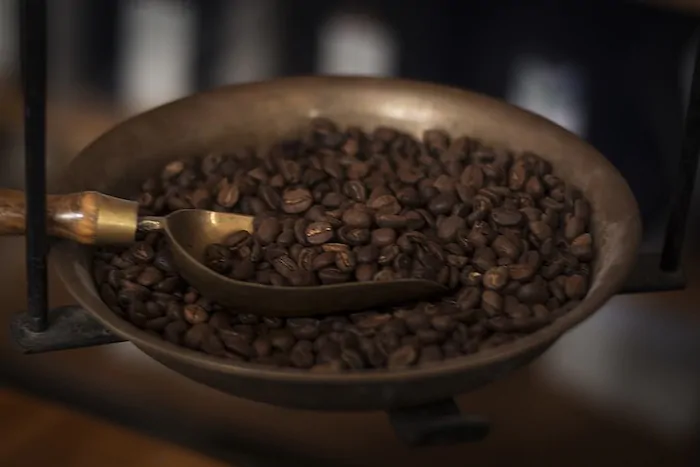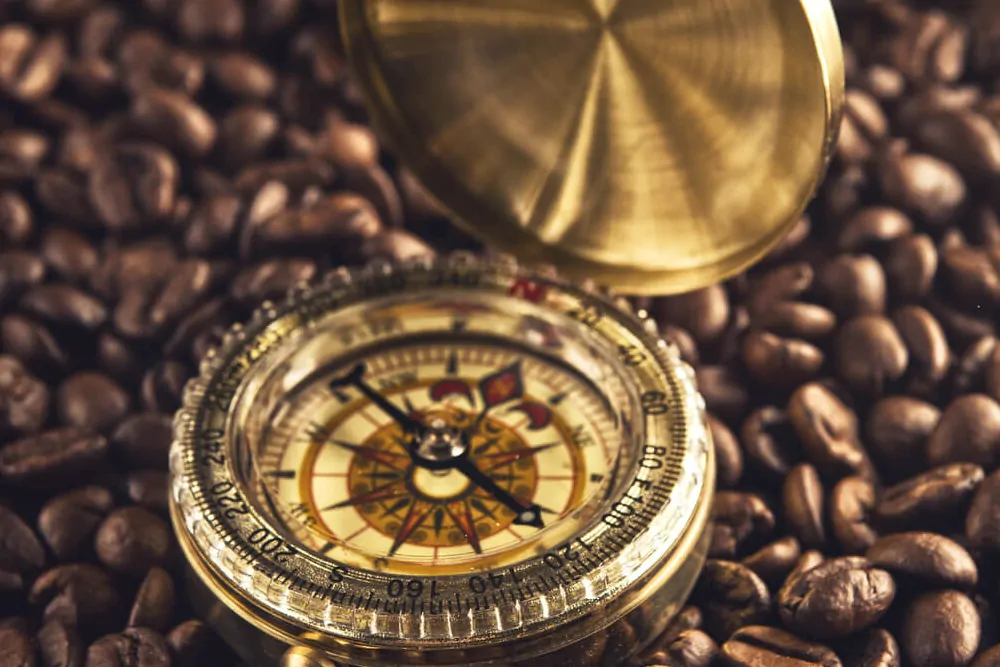You’re all out of coffee and then you open the press and find some beans from months ago. But are old coffee beans safe to drink?

When I see a killer sale on my favorite whole coffee beans, I try to buy as much as possible. I know I’m set for a long time that way. But sometimes, despite my best efforts, I can’t drink all of it before its “best by” date.
That made me wonder if it was even safe to drink old coffee beans. As you might have guessed, I did my research and came up with an unexpected answer.
Are old coffee beans safe to drink?
Yes! You can drink coffee made with old coffee beans without any negative health effects. However, it will not taste as good.
That answer made me feel much better about using up my older coffee beans, but it also left some new questions unanswered. I dug a bit deeper to discover some caveats to that, so read on for more about the safety of your old coffee beans.
Old Coffee Beans Can’t Hurt You… Probably
Old coffee beans aren’t dangerous to your health by themselves. They’ll taste stale and weak, but they’re not going to make you sick on their own. However, there are some things about old coffee beans you should be aware of.
Some of those things might make your stomach turn.
How Old Coffee Beans Can Make You Sick
While it is true that old coffee beans aren’t bad for your body all on their own, they can be the catalyst for bad things to happen. Most notably, old coffee beans can be a breeding ground for bacteria.
Some bacteria are harmless to healthy adults, but other types can make you very sick. Coffee machines often harbor bacteria such as staphylococcus and streptococcus. If you happen to have your coffee beans open while you brew your cup of Joe, you’re setting yourself up for contamination.
There’s also a mold.
Coffee Beans Can Grow Mold?
Yeah, I know. I was pretty grossed out when I learned that mold can grow on coffee beans. The mold that can grow on whole coffee beans or ground coffee can produce a nasty substance called ochratoxin A (also OTA).
Ochratoxin is bad for your kidneys and is thought to be a carcinogen. To further freak you out, carcinogens are believed to cause, or at least contribute to, the growth of various cancers. OTA can also suppress your immune system.
And you thought you were just drinking a cup of coffee!
Where Does OTA Come From?
Now, you might be thinking that mold can’t possibly grow in your pristine kitchen, but you’d be wrong. See, the OTA from coffee mold doesn’t have to come from your house. It’s possible that it rode in on the beans, to begin with.
That’s right, the toxin was in the beans all along. That’s because the mold that produces OTA is prevalent in areas that grow coffee. The warm, moist environment is perfect for it.
As if this news wasn’t bad enough, I’ve got another bomb to drop on you. OTA is resistant to both heat and high acid levels. You know, the very things that make up coffee bean roasting.
What Are The Chances My Coffee Is Contaminated With Ochratoxin?
One study said that more than 50% of the coffee beans they tested were contaminated with OTA.
The problem might be even bigger than that though. Cross-contamination is a major issue in coffee farming and processing. Even if a crop was originally OTA-free, if it was processed on contaminated machines, it’s contaminated now, too.
How Do I Avoid OTA-Contaminated Coffee Beans?

The best way to avoid OTA in your coffee is to know where your beans came from. Pay attention to the farm they were grown at, the plant they were processed in, and how they were shipped.
Insist on purchasing coffee beans from companies that test for OTA. It’s really that simple.
How Do I Make Sure My Old Coffee Is Safe To Drink?
There is no magic button to make sure your older coffee beans are safe to drink. There are far too many variables to make promises like that.
However, there are a few things you can do to give your coffee beans the best chance at staying safe and tasty for longer.
Keep coffee beans cold
This is the number one way to keep your coffee beans as safe as possible.
I know a lot of people who still keep their coffee beans at room temperature. While it’s okay to do this for a short period of time, extended storage at room temperature will accelerate the process of beans going bad. It can also encourage the growth of the mold that creates OTA.
So, just pop your whole beans in the freezer, or at least the refrigerator. Mold can’t grow in those temperatures. The cold will also extend the life of your coffee, saving some of the flavors as it ages.
Start with the best coffee
I cannot stress this enough. If you start with the best possible coffee, your chances of mold and OTA contamination are pretty slim. You also reduce your chances of bacterial contamination and mishandling.
Cheap coffee is cheap for a reason. The farmers took shortcuts. The processors took shortcuts. And, of course, the shippers and sellers took shortcuts, too. It’s just not worth risking your health to save a few bucks.
Keep a spotless coffee prep area
Assuming you’ve bought the best beans and stored them in the freezer, the rest of the safety is up to you. Keep your coffee preparation area spotless. That means you have to clean your counters, your utensils, and your coffee machines, too.
I shouldn’t have to say this, but I will anyway: wash your hands! The biggest factor to contaminated coffee is your dirty hands touching all those beans. Even if you use clean utensils and equipment, if your hands are nasty, you’re going to contaminate your coffee.
How Can You Tell If Old Coffee Has Gone Bad?

Since you can’t see, smell, or taste OTA and most bacteria, you’ll just have to follow my suggestions above to reduce your chances of getting sick. But contamination isn’t the only issue with old coffee.
Beans and ground coffee can both go rancid. The longer beans and grounds sit, the more likely they will go bad. It happens much faster in warmer environments, so don’t forget to chuck your coffee in the fridge or freezer.
You can usually tell right away when your coffee has gone bad. The smell will be acrid and rancid, a very unpleasant aroma the moment you open the bag.
It’s also possible to tell right before the coffee has gone bad if you pay attention. Fresh coffee has a strong and tempting smell. When coffee begins to go stale, it will lose that fresh smell. If it doesn’t smell bad, it’s still okay to drink, but you don’t have much time left.
Rancid coffee—coffee that’s gone totally bad—will have a nasty taste. If you can get past the bad smell, the taste is definitely going to ring some alarm bells. Personally, I can taste it right away and no amount of additives or flavor enhancers can cover it up.
What Can I Do With Old Coffee Beans?
I’m going to assume, once again, that you’ve purchased the very best beans, kept them in the freezer, and have a spotless kitchen. If so, you won’t need to toss old coffee beans that have lost their aroma and flavor. Here are a few ideas to get the most out of your old coffee beans and reduce waste in your home.
Sweet treats with old coffee beans
If you have old coffee beans that won’t make a good cup of Java, you can cover them with a variety of sweets. Try milk or dark chocolate, white chocolate, or yogurt.
Use them for color
Coffee grounds are a good way to add a dark color to many types of dishes without changing the flavor. The beans are stale and flavorless anyway.
Decorate with old coffee beans
Don’t worry, I’m not going to suggest you make a cute macaroni-style portrait for your mother. You can use old, stale coffee beans to decorate in a more mature way. One idea is to create interesting centerpieces with glass jars and candles.
Grind and scrub
If none of those ideas piques your interest, then just give those old coffee beans a course grind and use them to scrub pots and pans. The beans are acidic and abrasive, which works wonders on caked-on foods. Just be sure to test them on a pan you don’t care about. They might be a little too powerful for some types of kitchenware.
Compost
My friend is a gardening nut, and she is always asking me for my coffee grounds. I usually give her my used grounds, but recently she reminded me that old, stale coffee beans work, too. Old coffee beans contain phosphorus, potassium, copper, and magnesium, all the great things gardeners want in their soil.
Related Questions
How long can coffee beans be stored?
Depending on their original freshness, you can store coffee beans for up to 6 months in the freezer (not recommended). Coffee stored on the counter should be used within 2 weeks.
Do whole coffee beans go bad?
Yes, they can go bad. They can get stale, which reduces their aroma and flavor. They can also go rancid, which makes them smell and taste bad. Rancid coffee beans can also cause gastric upset.
Related Article: WHY ARE SOME COFFEE BEANS OILY?

